Creating engaging tweets is essential for connecting with your audience and fostering interaction. By focusing on clarity, relevance, and the use of visuals, you can capture attention and encourage community engagement. Employing techniques such as asking questions and sharing user-generated content can further enhance your tweet’s impact and resonance with followers.
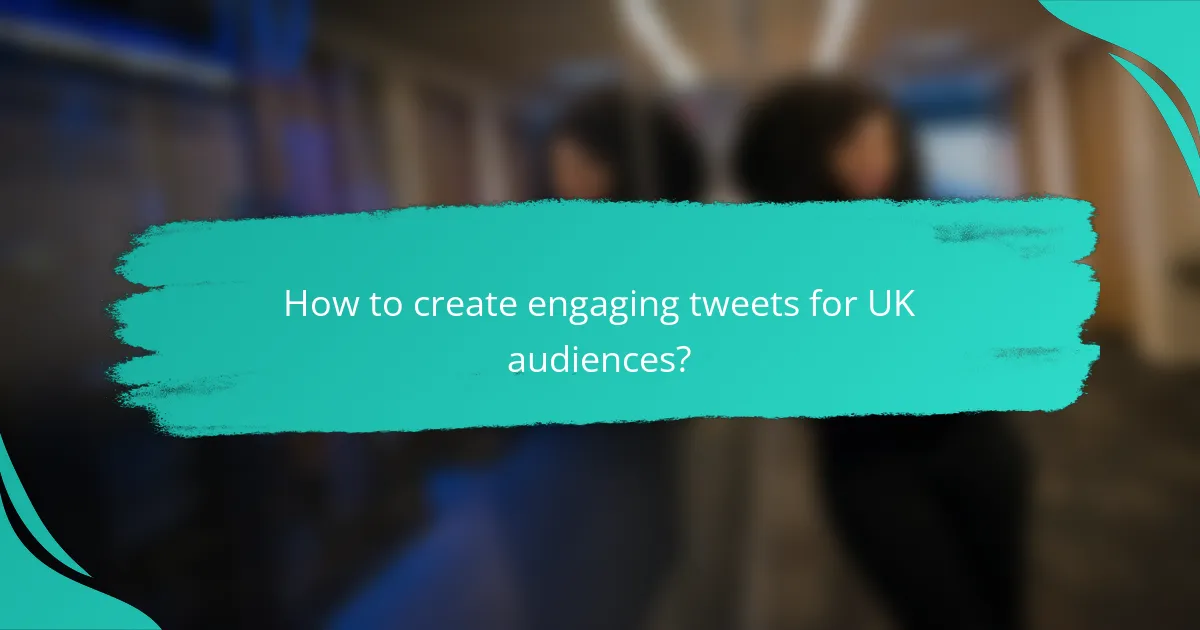
How to create engaging tweets for UK audiences?
To create engaging tweets for UK audiences, focus on clarity, relevance, and interaction. Use concise language, trending hashtags, and visuals to capture attention while fostering direct engagement with your followers.
Use concise language
Concise language is crucial for effective tweets, as character limits require clarity. Aim for brevity by using simple words and phrases that convey your message quickly.
Try to keep your tweets under 100 characters to ensure they are easily digestible. This approach helps maintain the reader’s attention and encourages retweets.
Incorporate trending hashtags
Trending hashtags can significantly increase the visibility of your tweets. Research popular hashtags relevant to your content and include them to reach a broader audience.
Utilize tools like Twitter’s trending section or hashtag analytics platforms to identify which hashtags are currently popular in the UK. Aim for 1-3 hashtags per tweet for optimal engagement without overwhelming your message.
Utilize visuals and media
Incorporating visuals such as images, GIFs, or videos can enhance engagement. Tweets with media tend to receive higher interaction rates compared to text-only tweets.
Consider using high-quality images or short videos that relate to your content. A well-placed visual can capture attention and convey information more effectively than text alone.
Engage with followers directly
Direct engagement with your followers fosters a sense of community and loyalty. Respond to comments, retweet user-generated content, and ask questions to encourage interaction.
Make it a habit to acknowledge mentions and replies promptly. This not only boosts your visibility but also shows that you value your audience’s input.
Post at optimal times
Timing your tweets can significantly impact engagement levels. Research suggests that posting during peak hours, such as lunchtime or early evenings in the UK, can lead to better visibility.
Experiment with different posting times and analyze engagement metrics to find the optimal schedule for your audience. Tools like Twitter Analytics can help you track performance and adjust your strategy accordingly.
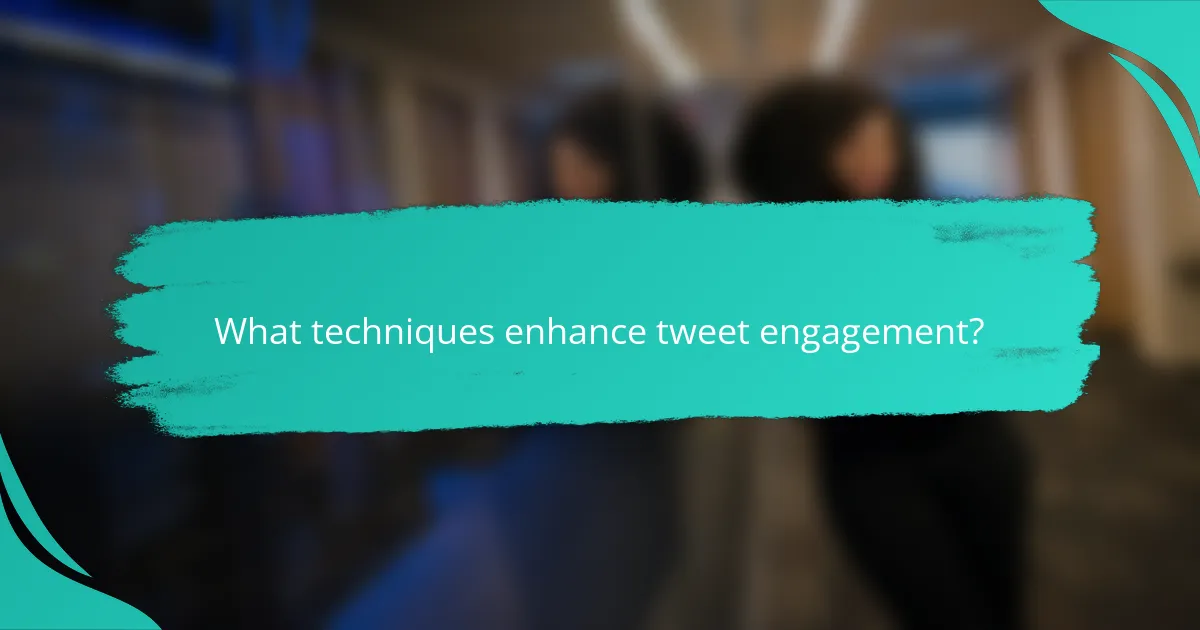
What techniques enhance tweet engagement?
Techniques that enhance tweet engagement include asking questions, sharing user-generated content, and running polls. These strategies encourage interaction and foster a sense of community among followers.
Ask questions to prompt responses
Asking questions in your tweets is a powerful way to prompt responses from your audience. Open-ended questions tend to generate more engagement than yes-or-no queries, as they invite followers to share their thoughts and experiences.
For example, instead of asking, “Do you like coffee?” consider asking, “What’s your favorite way to enjoy coffee?” This invites a wider range of responses and encourages conversation.
Share user-generated content
Sharing user-generated content (UGC) is an effective strategy to boost engagement. By featuring posts from your followers, you not only acknowledge their contributions but also create a sense of community around your brand.
Encourage your audience to share their experiences with your product or service, and then retweet or highlight their content. This not only increases engagement but also builds trust and loyalty among your followers.
Run polls for interaction
Running polls is a straightforward way to engage your audience and gather opinions. Twitter’s built-in poll feature allows you to ask questions and provide multiple-choice answers, making it easy for followers to participate.
Consider using polls to gauge preferences or opinions on topics relevant to your audience. For instance, you could ask, “Which product feature do you value most?” This not only drives engagement but also provides valuable insights into your audience’s preferences.
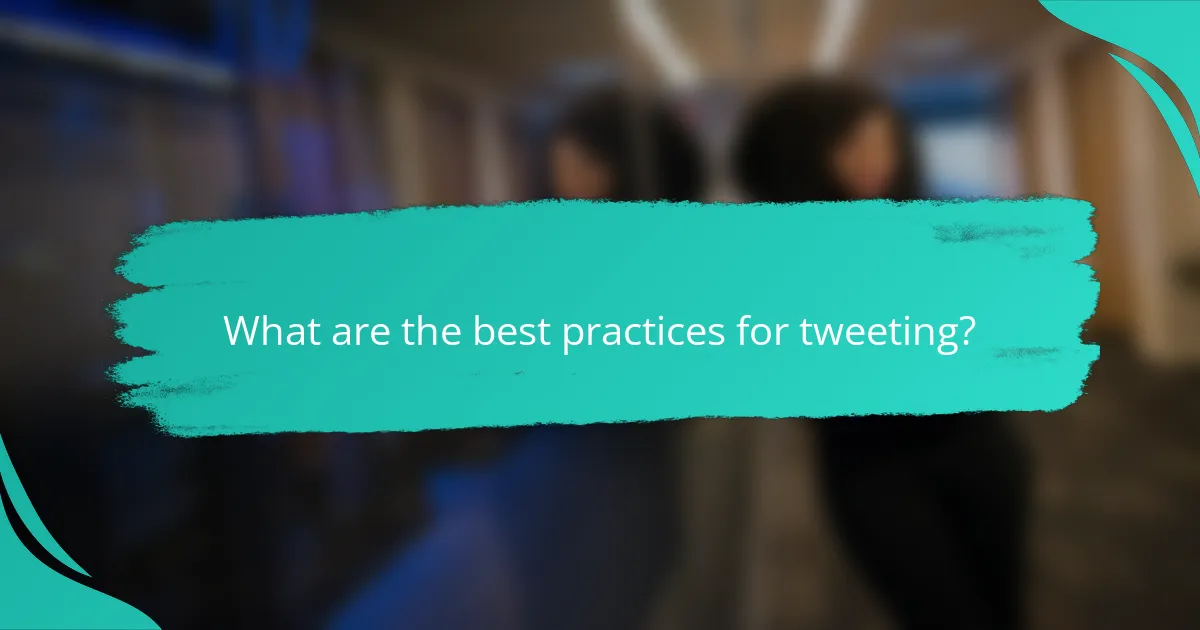
What are the best practices for tweeting?
The best practices for tweeting focus on creating engaging content that resonates with your audience while maintaining a consistent brand presence. Effective tweets should be concise, relevant, and visually appealing to capture attention quickly.
Maintain a consistent brand voice
Having a consistent brand voice is crucial for building recognition and trust on Twitter. Your tone should reflect your brand’s personality, whether it’s professional, casual, or humorous. This consistency helps followers understand what to expect from your tweets.
To achieve this, develop a style guide that outlines key elements like vocabulary, tone, and messaging. Regularly review your tweets to ensure they align with your established voice, avoiding drastic shifts that could confuse your audience.
Monitor analytics for insights
Monitoring analytics is essential for understanding how your tweets perform and what resonates with your audience. Twitter Analytics provides valuable data on engagement rates, impressions, and follower demographics, helping you refine your strategy.
Regularly analyze which types of content generate the most interaction. For example, if tweets with images receive higher engagement, consider incorporating more visuals into your posts. Aim to review your analytics at least monthly to stay informed about trends and adjust your approach accordingly.
Experiment with tweet formats
Experimenting with different tweet formats can enhance engagement and reach. Consider using images, videos, polls, or threads to diversify your content and keep your audience interested. Each format can serve different purposes, from storytelling to quick updates.
For instance, polls can encourage interaction and provide insights into follower preferences, while threads allow for deeper storytelling. Test various formats to see what works best for your audience, and don’t hesitate to adapt based on their responses.
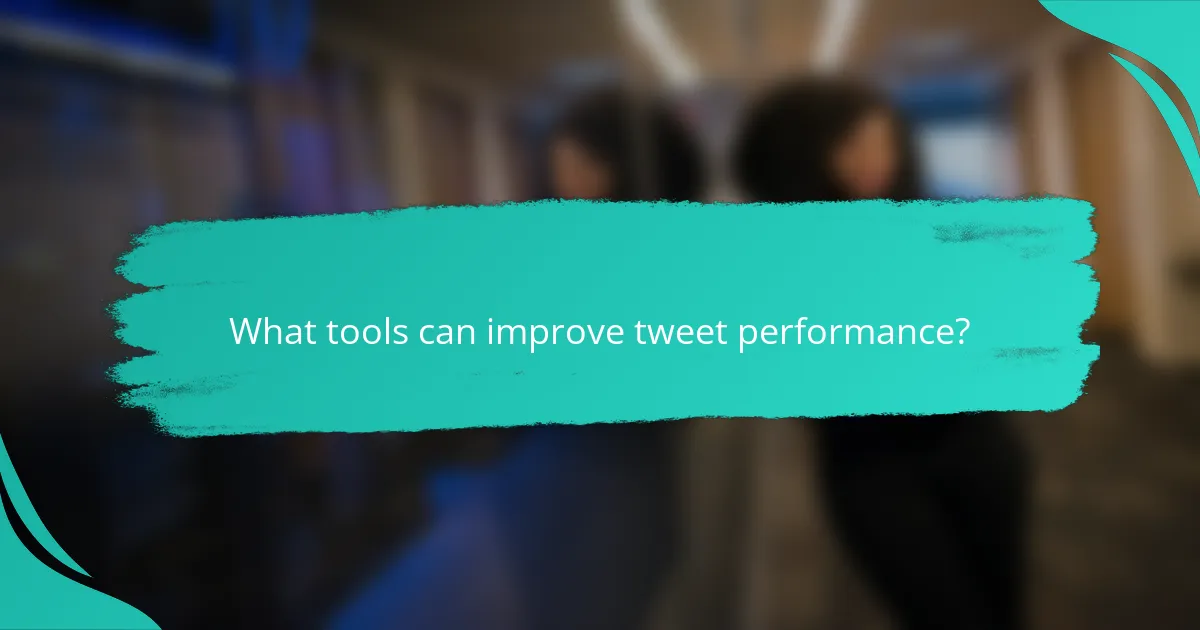
What tools can improve tweet performance?
Several tools can significantly enhance tweet performance by optimizing scheduling, creating engaging visuals, and analyzing engagement metrics. Utilizing these tools can help streamline your Twitter strategy and improve audience interaction.
Buffer for scheduling
Buffer is a popular tool for scheduling tweets at optimal times to reach your audience effectively. By allowing you to plan and automate your posts, it helps maintain a consistent presence on Twitter without requiring constant manual updates.
To get the most out of Buffer, consider analyzing your audience’s online activity to determine the best times to post. This can lead to higher engagement rates and better visibility for your tweets.
Canva for graphics
Canva is an excellent resource for creating eye-catching graphics that can accompany your tweets. With its user-friendly interface and a wide range of templates, you can design visuals that resonate with your audience and enhance the overall appeal of your content.
When using Canva, focus on maintaining brand consistency in colors and fonts. Engaging visuals can increase retweets and likes, making your tweets more shareable and memorable.
Tweepsmap for analytics
Tweepsmap provides valuable analytics that help you understand your audience better and refine your Twitter strategy. By offering insights into follower demographics, engagement rates, and tweet performance, it enables you to make data-driven decisions.
Utilizing Tweepsmap can help identify trends in your audience’s behavior, allowing you to tailor your content more effectively. Regularly reviewing these analytics can lead to improved engagement and a stronger connection with your followers.
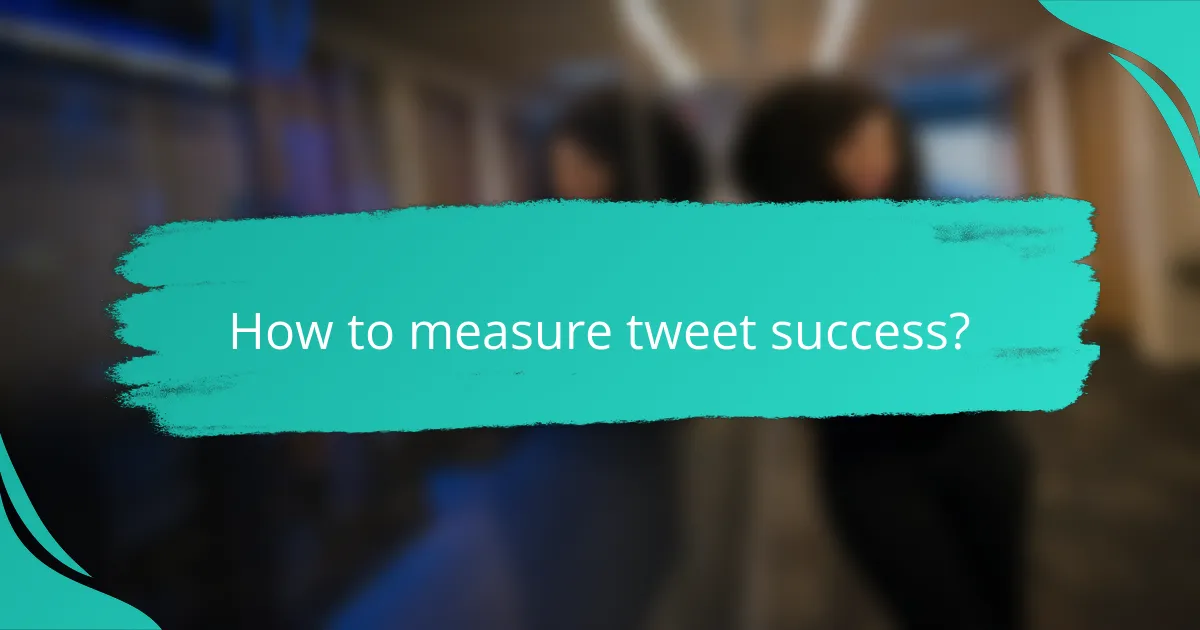
How to measure tweet success?
Measuring tweet success involves evaluating various metrics that indicate how well your tweets are performing. Key indicators include engagement rates, follower growth, and click-through rates, which collectively provide insight into audience interaction and content effectiveness.
Track engagement rates
Engagement rates reflect how users interact with your tweets through likes, retweets, replies, and mentions. A higher engagement rate indicates that your content resonates with your audience. Aim for engagement rates in the low single digits to mid-teens, depending on your industry.
To track engagement, use Twitter Analytics or third-party tools to monitor these interactions over time. Regularly assess which types of content generate the most engagement and adjust your strategy accordingly.
Analyze follower growth
Follower growth is a crucial metric that shows how your audience is expanding. A steady increase in followers suggests that your content is appealing and that your brand is gaining visibility. Monitor your follower count weekly or monthly to identify trends.
Consider factors that may influence follower growth, such as tweet frequency, content quality, and engagement with followers. Avoid sudden spikes in follower count that may indicate spam accounts, as these can skew your metrics.
Evaluate click-through rates
Click-through rates (CTR) measure how often users click on links within your tweets. A higher CTR indicates that your audience finds your content valuable enough to explore further. Aim for a CTR of around 1-3%, depending on the type of content shared.
To improve CTR, use compelling calls to action and ensure that your links lead to relevant, high-quality content. Regularly analyze which tweets generate the most clicks and refine your approach based on these insights.
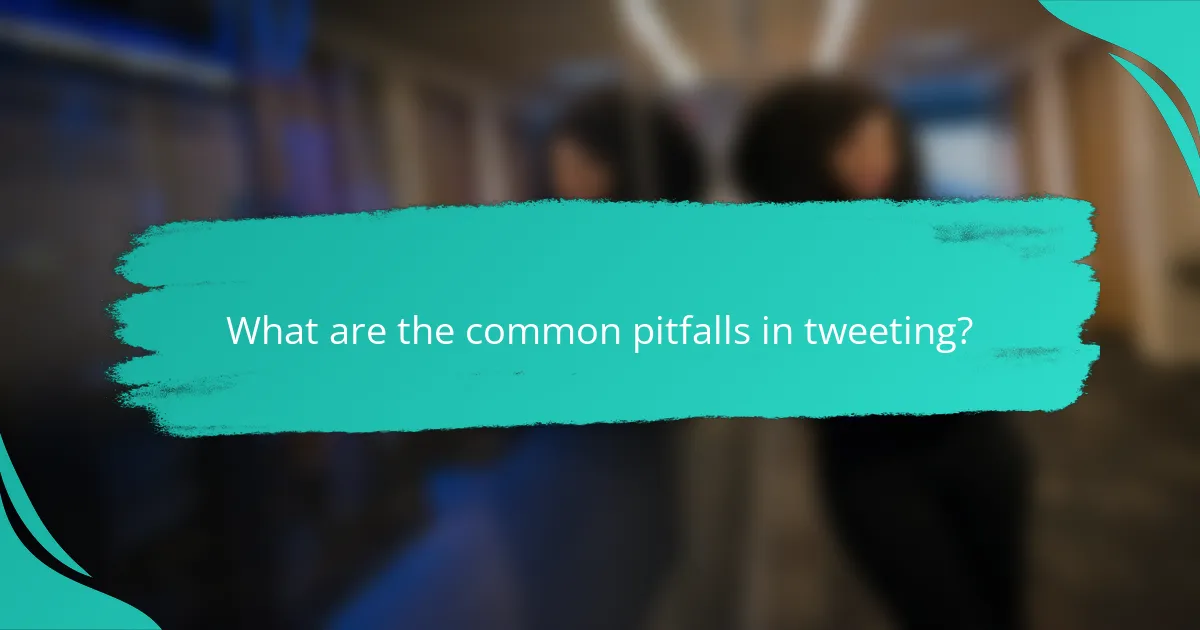
What are the common pitfalls in tweeting?
Common pitfalls in tweeting include overusing hashtags, neglecting engagement, and failing to maintain a consistent voice. These mistakes can dilute your message and reduce the effectiveness of your tweets, making it harder to connect with your audience.
Overusing hashtags
Overusing hashtags can clutter your tweet and distract from your main message. While hashtags can increase visibility, using too many can make your content appear spammy and unprofessional. Aim for one to three relevant hashtags per tweet to maintain clarity.
Consider the context of your audience when selecting hashtags. Popular hashtags can boost reach, but niche hashtags may attract a more engaged audience. For example, using #TravelTips alongside #Travel can help you connect with both broad and specific audiences.
To avoid the pitfall of overusing hashtags, create a checklist before posting. Ask yourself if each hashtag adds value, if it’s relevant to your tweet, and if it aligns with your brand voice. This practice can help you maintain focus and enhance your tweet’s effectiveness.
